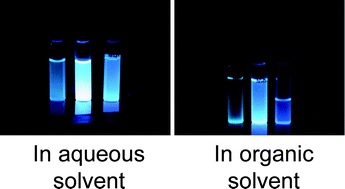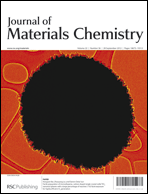Syntheses of 2,3,4,5-tetraphenylcyclopenta-2,4-dienyl benzene derivatives tailored with seven substituents of various lengths and molecular composition were accomplished and their UV-Vis and fluorescence properties investigated. All of the novel fluorescent dyes displayed varying degrees of aggregation-induced emission (AIE) in the blue region of ∼460 nm in various organic and aqueous solvents. Interestingly, the studies revealed the novel ability of this family of molecules to show strong luminescence in both organic solvents (e.g., %Φf = 69.0% in toluene) and aqueous solutions (e.g., %Φf = 14.0% in H2O) without the need to mix organic and aqueous solvents. Furthermore, fluorescence properties as a function of temperature indicated that both aggregation-induced behavior and the initial degree of solubility played an important role in the overall observed properties of the fluorescent dyes. The importance of this family of molecules for nucleic acid detection and bioimaging applications was demonstrated via the “turn off” detection of cDNA and ss-DNA and by successful tagging and imaging of lens epithelial cells. Taken together, these findings are of great importance for they provide a platform for further rational design and synthesis of luminescent (due to aggregation-induced) and biocompatible (non-toxic) nanoparticles for a wide range of imaging and sensory applications.

You have access to this article
 Please wait while we load your content...
Something went wrong. Try again?
Please wait while we load your content...
Something went wrong. Try again?


 Please wait while we load your content...
Please wait while we load your content...